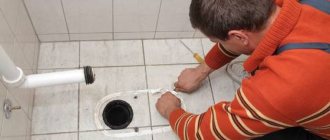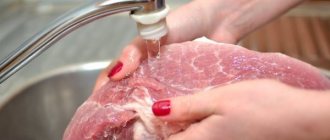How to protect the countertop from moisture: processing joints, recommendations
The kitchen is one of the places in the house where furniture is constantly in contact with water. As a result, the material wears out, and over time, swelling, cracks and chips may appear on it. Read on to learn how to protect your countertop from swelling.
Features of protecting kitchen furniture from water
There are always risk areas in kitchen furniture that need to be monitored especially carefully. This is a cabinet with a dryer, a sink and a cabinet with a washing machine. They are often the reason for repairs or replacement of the headset. When purchasing, it is better to give preference to moisture-resistant material. However, the manufacturer only provides a guarantee for a solid tabletop. First of all, the correct selection and installation of furniture is important.
Correct installation of sink and faucet
When purchasing a sink, you should pay attention to the feature of the locking connection. The locks should snap onto the tabs and not just click. When installing, it is advisable to use silicone sealant. When drying, it forms a protective film that protects against moisture. A thick layer of sealant is usually applied to the joint between the countertop and the wall and the cutout under the sink. The sealant is easy to check for quality. To do this, leave the drop at room temperature for three hours. If it has frozen and does not leave marks on your hands, then the product can be safely used at work.
Note! Experts do not recommend embedding the faucet directly into the countertop, as the faucet will sooner or later begin to leak. This will cause the surface to swell. An exception is made for drinking filters.
Drying installation
When choosing a dryer, you should pay attention to whether the set includes a tray. If it is not provided, then water draining from the dishes will fall to the bottom of the cabinet, which will subsequently lead to swelling of the surface. Good ventilation of the dryer is also necessary. To do this, make a small hole in the cabinet, which is designed in the form of a socket for the wire.
Kitchen plinth protection
When choosing a kitchen plinth, it is better to give preference to plastic. The panel will close the gap between the cabinet and the floor. The design is equipped with grooves for fastening to supports and a seal that protects against the ingress of water and dirt. The advantages of the plinth are as follows:
- simplicity and ease of installation;
- a light weight;
- wide choice of colors;
- moisture resistance;
- different heights: 100, 120 and 150 mm.
Protecting the edges of the tabletop
It is better to cover the edges with special strips, the choice of which depends on the installation method. The end is pre-treated with silicone. One of the popular techniques is to apply several layers of paraffin, PVA glue or varnish to the sections. Some people use self-adhesive tape or wide tape.
How to coat and treat chipboard from moisture
Due to its low cost and good performance properties, chipboard has become a very popular material. The main enemy of these plates is water. After all, sawdust increases in volume when wet and the base wrinkles. Next, we’ll look at how to increase the moisture resistance of the material.
The first step towards moisture resistance
Even at the production stage, the process of resinizing the chips is carried out. Thanks to this, the fibers are saturated with resins and glued together. Formaldehyde resin itself is already a hydrophobic component of the product. A stronger substance is urea-melamine resin. The moisture resistance of chipboard is increased by the introduction of paraffin or its concentrate into the chips.
Surface treatment of plates
It will not be superfluous to process the front and back sides of the slab. One of the effective techniques is lamination. A melamine film is laid on the treated board under high temperature and pressure. As a result, the film forms a single block with the plate. At home, chipboard is painted in several layers, following the following steps:
- all contaminants are removed from the surface;
- the plate is treated with heated drying oil;
- then treat with cold drying oil until a crust forms;
- dyeing process.
Important! Each subsequent layer of paint is applied to the completely dry previous one.
Processing joints and edges
Before processing, the joint should be cleaned and dried with a hairdryer. Next, a logical question arises: what is the best way to treat the edges of a chipboard tabletop so that they do not swell. PVA glue or sealant will come to the rescue. In places where there is no lamination, end and connecting strips made of metal and plastic are fixed.
Sealing chipboard joints on the floor
Floor slabs are regularly subjected to great physical stress and tend to move relative to each other. Therefore, putty does not help in this case. The seams are treated with a mixture of epoxy and crushed sawdust. The composition hardens instantly, so it is better to make a small batch. You can make a mixture of hot glue and sawdust. The glue penetrates deep into the porous structure and the joint stops moving. This is one of the budget and reliable methods. True, the glue takes a long time to dry and it’s better not to walk on the floor for a couple of days.
Plastic countertop repair
To remove cracks and chips, you can use a special fastening glue for plastic, which is applied with a gun. If the surface is not badly damaged, regular superglue will do. To cover the flaws, the plastic is ground to a powdery mass and mixed with glue. The resulting mass is used to fill the chips.
Additional Information! For large tables it is worth buying Titan glue.
Laminated models and their repair
Laminated surfaces, despite their durability, also wear out. If the tabletop is swollen, you can fix it in the following way:
- heat the deformed area with a hairdryer;
- remove the damaged piece;
- treat the damaged area with glue;
- pour the prepared mixture of sawdust and PVA into the damaged area;
- compact the mixture with a spatula;
- the surface should dry within 24 hours.
How to properly update and care for your countertop
You can update your countertop in different ways. Here everything depends on the author’s imagination. One of the simplest methods is painting and decorative painting. You can also cover it with decorative tiles, such as mosaics. Using tempered glass is the most expensive method. To ensure that the results of the restoration are pleasing for as long as possible, be sure to use cutting boards and hot mats for cutting food. And for washing, use gentle cleaning products.
Helpful tips for preventing swelling
Be sure to take advantage of the kitchen assembly service. Otherwise, the company will withdraw its warranty obligations. It is necessary to take care of the installation of the hood. It will not only get rid of unpleasant odors, but will also protect furniture from condensation, steam and grease drops. Remove moisture from the surface in a timely manner and do not leave it wet overnight. Otherwise, the material will begin to swell. The base can be rubbed with stearin and then heated with warm air. After cooling, repeat the procedure several times. You can make a coating from a mixture of bitumen varnish and drying oil in a ratio of 1:5.
What kind of wood for the countertop?
When choosing wooden countertops for the bathroom, you should remember about their systematic impregnation and maintenance. The right type of wood will also be important. It is best to choose exotic woods that tolerate moisture well, or hard local varieties such as oak. The material must have a low degree of shrinkage, not absorb moisture and have a low level of humidity.
The wooden countertop in the bathroom is made of solid or laminated wood. The latter type is more resistant to changes in temperature and high humidity; it does not deform or crack.
Furniture is swollen from water, what should I do?
One of the most common troubles that can happen to kitchen furniture made from chipboard is excess moisture getting on it and further swelling (swelling). There can be many reasons for such disgrace. For example, a favorite flower in a pot is conveniently placed on the top shelf of the cabinet.
If you do not properly protect the surface from moisture penetration (and you need to water the flower regularly). As a result, we can get this picture.
In our case, the structural qualities of our chipboard shelf (cabinet) were not damaged; only the edge of the shelf was swollen and deformed. There is no talk of replacing it with a new one. Moreover, this means actually remodeling and disassembling the entire cabinet completely. We only need to fix the aesthetic, visible part of the shelf, swollen from water. This is what we will do. We will not disassemble, remove or replace anything. Our shelf will remain in its original place.
The most acceptable, non-labor-intensive and low-cost way out of this situation is to decorate (cover) the end of our shelf that is swollen (swollen) from water with a plastic corner. It’s simple and completely doable with your own hands.
DIY chipboard shelf repair in the kitchen
What should you do if the edge of a chipboard shelf in your kitchen furniture is swollen? Cosmetic repair of swollen chipboard.
We will need a plastic corner of the desired color (in our case, white) and glue.
We used Dragon glue, which was quite suitable for our purpose. But there may be other options at your discretion.
Next, measure and cut the corner along the length of the shelf or edge of the cabinet, coat the inside of the corner with glue and apply it to the area of the swollen chipboard.
If you have such a useful thing as clamps, use them to secure a corner to the edge of the shelf and leave it for a day.
This way our decor will stick tightly to the edge of the shelf.
If there is no clamp, you can simply press the corner with something heavy (for example, a stack of books) until the glue dries completely.
This is what our decorative repair of swollen chipboard in the kitchen looks like.
We managed to correct the aesthetic picture.
At the initial stage of the problem (as an ambulance), you can use regular nail polish.
Just dry the swelling area thoroughly with a hairdryer, and then coat the problem areas with colorless varnish. After drying and absorbing, it prevents moisture from entering and serves as a waterproofing agent. But this only helps at the early stage of soaking to slow down the process for a short period of time
But for the future, it is necessary to eliminate the source of unwanted excess moisture. If this is a pot with a living flower, you need to place a tray under it (for example, a regular plastic tray). And in the future, try to prevent water from getting on such a moisture-sensitive surface.
We will tell you how and how to cover (protect) the top of the kitchen from grease, dust and moisture. Simple techniques will help you keep your kitchen clean without much effort or expense.
Wood protective coating
A high-quality coating will protect the wooden tabletop from moisture penetration, scratches and stubborn stains. The tree is covered with:
- Oil and wax. The oil-wax mixture penetrates the wood structure and makes the countertop moisture resistant. The ideal option is bio-impregnation with beeswax and vegetable oil. Mineral and synthetic oils are also used.
- Water-dispersed compositions and varnish. The wood is covered with stain or colored glaze, and then varnished. It is important that the varnish is moisture resistant. It is applied in 2-3 layers. A durable film is formed on the surface, protecting the wood from damage.
- Polyurethane varnishes. Unlike conventional varnishes, they create an elastic film on the surface. She is not afraid of hot objects, does not chip, does not scratch. It comes in glossy, matte and semi-matte. Its only drawback is the high price.
We recommend: 65% of people wash dishes incorrectly! Find out what's the catch
Chipboard after a flood - what to do?
Good afternoon After a flood, as a result of which chipboard furniture was left in a few centimeters of hot water for several hours, I’m wondering what to do. Wait until the chipboard dries - but it has already split in half everywhere. all this is the bottom of the furniture, its basis. the rest of the furniture, despite the fact that the air humidity was almost 100% for several hours, seems like nothing yet. but what to do with the swollen base? The closet has swelled about 3 centimeters from the bottom, see two at the chest of drawers and shelving. Is there a way to at least extend the life of furniture after such an accident? cut down what is swollen due to the base? any other ways?
Cut above the swollen area. And don’t wait for it to dry completely, because... residual moisture will rise higher “through the capillaries”. You know it yourself - the water will find a hole. It will not be possible to shrink the swollen area to the original 16 mm. In principle, furniture can stand on swollen “legs” for a long time, but the appearance is still the same.
Another option is to order new panels to replace the damaged ones. But getting the color right may not be easy.
tatoops wrote: Is there a way to at least extend the life of furniture after such an accident? cut down what is swollen due to the base?
If the base is structurally a separate element, then only change it on all the furniture and it doesn’t matter if the color doesn’t match, the main thing is that it will be the same everywhere (like this trick). If the damaged furniture stands on the sides (the legs are a single part with the side part), then try (if possible) to cut off the damaged part and build a plinth on which to install the cut furniture. The design must be adjusted to the location. If this does not work, then replace the damaged parts entirely. I had a flood, but it was cold water in the kitchen, about 1 cm of water within 1 hour. I managed to fight it off by clamping the lower parts through the boards with clamps and drying them with a hairdryer
. Moreover, you have to do everything quickly; if it dries before it’s compressed with clamps, it won’t work anymore. It turned out tolerably, I only changed the front panels covering the base. Good luck .
What is a wooden slab
The technological effectiveness of wood processing methods allows us to obtain a variety of building materials that combine quality and aesthetics. But the modern trend puts at its peak the popularity of precisely those materials that have retained the qualities of natural wood as much as possible.
Slabs are wide cuts made along a tree trunk. Solid cuts are used in the manufacture of furniture, and species such as elm, oak or poplar are used. Other options can be considered, but the strength of the wood and its grain should be taken into account. The longitudinal section reveals the cut of the fibers, emphasizing the natural beauty and grandeur of the wood.
Instead of the word “Slab” you can use “Board”, “Saw”, “Cut”, “Solid”. In principle, these concepts are identical, however, in the manufacture of countertops, it is the terminology that is unusual for the Russian lexicon that is used. The thickness of the cut slab can vary from 5 to 15 cm. For cuts, mainly the lower parts of the trunk are used due to the resulting thicker slabs.
Expert opinion
Oleg Vasiliev
Master of making furniture and interior items from epoxy resin. She creates unique items to order in her own production.
to the master
And yet, the term “slab” is more often used to name longitudinal boards, and “cut” is used for cross sections of logs. The lower parts of the trunk are used to obtain the widest slabs and cuts of the largest diameter. In addition, closer to the root, the texture of the slabs may contain natural unevenness, which is especially valued by customers.
We suggest you read: Are cucumbers carbohydrates or proteins?
“Live edge” is translated literally as “live edge” and refers, rather, to the appearance of the long sides of the tabletop (along the grain), which are not cut at 90° degrees, but follow the natural outer contours of the trunk. The main surface of the table, on which dishes or other objects are placed, can be finished and even polished.
It is unlikely that you will be able to make a slab yourself, since cutting requires special equipment. Usually production is established right in the forest, because tree trunks with a diameter of up to 1 meter are used as the initial raw material. Birch, aspen and oak have beautiful patterns and unique textures.
One of the mandatory stages of slab preparation is drying the slab. Under suitable weather conditions, the sawn wood dries naturally; otherwise, infrared radiation and forced ventilation must be used. Drying time may vary. The time directly depends on the type of wood, the geometry of the slab, the initial humidity and drying conditions. Temperature changes, as well as sudden changes in humidity, lead to the formation of cracks in the array.
If there is a desire to combat this phenomenon, then the slabs are pre-coated with special compounds. But some designers specifically choose layers that contain defects.
Expert opinion
Oleg Vasiliev
Master of making furniture and interior items from epoxy resin. She creates unique items to order in her own production.
to the master
Drying technology is a whole industry in woodworking. For example, natural drying of a slab can take years. It is impossible to do without the use of special equipment that allows drying according to separate programs for different types of wood, its thickness and even taking into account the time of year.
Chipboard furniture repair and chipboard repair
Probably each of us has seen swollen chipboard. Most people think that after swelling this material cannot be restored and products made from it must be immediately disposed of. However, in practice it turns out to be completely different and repairing furniture made of chipboard is possible if you have certain knowledge.
Restoring moisture-swollen chipboard
Surely many people are familiar with the picture when chipboard swells after exposure to moisture. Most people in such situations immediately despair, but in fact it’s in vain, because repairing chipboard furniture after swelling is possible. To do this you will need:
- Furniture glue (you can use simple PVA);
- Sharp stationery knife;
- Several bars;
- Carpenter's saw (it will be needed for deepening and milling);
- Clamps;
And this is the process itself:
First, you need to heat the swelling area with a hairdryer and tear off the edge from it. Then you need to make a depression in the center at the site of the swelling using a circular saw (the height and depth of the milling must be greater than the site of the swelling).
Wooden tabletop, tools and materials
First, we must prepare the necessary tools, without which we cannot cope with this task. This is the grinder, saw and jigsaw needed to cut out the holes for the sink and water pipes.
The corners and side edges of the tabletop are protected from damage using special corners.
Swelling of the countertop in the kitchen: what to do and how to treat swelling
When choosing a kitchen set, many first of all think about the facade, color, drawers, and the question of what kind of countertop should be fades into the background. Maybe that's why it causes the most problems. Tables made of stone, glass, stainless steel, and ceramic tiles have found their place in modern kitchens, but most often solid wood or chipboard sheets lined with plastic are used as the main material.
If you do not know how to protect the surface, there is a risk of its deformation and rapid destruction under the influence of moisture and other negative factors. What to do if the tabletop suddenly swells, and how to fix it?
- What causes the tabletop to swell?
- Most common reasons
- Who is guilty
- What to do
- The reason for the swelling of the film countertop in the kitchen
- The countertop near the sink is swollen: how to fix it
- How to protect your countertop from swelling
- Conclusion
What causes the tabletop to swell?
The table surface is the most vulnerable part of kitchen units. Most often, damage to countertops can be associated with manufacturing defects, improper installation or violation of operating rules.
Most common reasons
The slab swells due to prolonged contact with water or improper care. And the cause of delamination, when plastic peels off from a chipboard, is prolonged exposure to extremely high temperatures or manufacturer defects (for example, insufficient amount of glue applied under the plastic). How to determine whether it is a manufacturing defect or furniture damage?
Who is guilty
In finding the culprit, you need to answer three important questions:
1. Was an instruction manual issued?
The buyer is not a priori required to know how to care for the countertop, what can be done with it and what cannot. The seller must take care of this. If not, the seller is to blame, and any court will side with the client. The consumer protection law is very strict.
2. Did the client follow the operating instructions?
This is not difficult to determine: the presence of black plaque (mold) along the edges of the sink, under the baseboard along the walls, indicates that water constantly remained on the countertop. After all, mold does not form in a dry, clean place.
Therefore, the client will have to change the countertop at his own expense or thank the company if it changed the countertop without a warranty claim.
3. Has the company fulfilled its obligations to properly install the sink?
If the kitchen installation was carried out by the selling company, then the assembler was obliged to ensure that all cutouts, cuts and joints of the countertop were sealed. The methods may be different, but the main thing is that there must be sealing!
Blistering of the surface indicates that the installation was carried out with errors. And the one who broke the rules is to blame. Often the court finds the seller guilty.
What to do
Manufacturers usually provide a warranty of at least 12 months on items such as countertops. If the canvas that has lost its appearance is part of a kitchen set that was ordered from a store that sells factory kits or from a furniture factory, then the warranty may be two years.
If the installation of the kitchen and installation of the sink were carried out by specialists from a trade organization or representatives of the manufacturer, you just need to fill out and send a complaint to the supplier’s email address or contact the director of the enterprise by phone.
If the product warranty expires, you must make a written claim and send it by registered mail to the address of the furniture factory or to the seller’s registered address. The check issued by the post office must be retained as evidence. It will come in handy in court.
If there is no warranty for the product, you can ask for help from professionals or try to carry out the restoration yourself.
The reason for the swelling of the film countertop in the kitchen
The main reason is still the same - water. It does not destroy the film, but the chipboard base. The wood board itself is used very often in construction and repair work; furniture is made from it. This is an alternative to an array, which is expensive. If used correctly, there will be no problems for many years.
You must know the basic rules:
- The surface of the stove is protected by a decorative film; it must not be damaged with a knife or heated, otherwise water will penetrate inside.
- All joints must be covered: in places where sinks and gas stoves are inserted, an insulating layer is required.
- Monitor the quality of the sealant regularly. Wipe up any water spills or splashes immediately.
The countertop may also swell next to the stove if the fire was strong. The film will burst, and then the chipboard will swell.
The countertop near the sink is swollen: how to fix it
If the laminated coating has come off, but the canvas has not swollen, you need to treat all joints and corners with a special sealant or silicone. When installing a countertop, it is advisable to treat the surface on which it is installed with silicone . When installing the sink, treat all edges with waterproof sealant.
If the surface is not only damaged, but also swollen, a number of actions should be taken to restore the shape of the slab.
Hardening and sealing wood - manipulations that increase the practicality of the material
To minimize damage from moisture and other external irritants, solid wood can be hardened. True, this manipulation is very different from the approach used in the case of metal:
- Pour a little heated mineral (not food!) oil onto the working area. We wait a few minutes until the fibers absorb the required amount of product.
- Take a rag and begin to rub the composition into the surface, working in the direction of the fibers.
- Leave the structure for half an hour so that the main component is well absorbed. We make sure that no drops of water fall on the tabletop at this time; this will reduce the effectiveness of the approach.
- Wipe the treated area with a waffle or paper towel, removing excess oil.
If the base material is chipboard sheets, then the optimal protection against damage will be the sealing procedure. To carry it out, we use ready-made polyurethane (for the food industry), which we apply to the problem area in at least three layers. After such a simple manipulation, there will be no problems with cleaning the countertop, and it will become indifferent to the effects of moisture. You still can’t cut food on such a coating!
Furniture wax can be useful to restore wood and eliminate traces of cracks. To do this, heat it on the stove or in the microwave. For one part of the product, take four parts of mineral oil and mix. While still warm, treat problem areas, carefully rubbing the product into the cracks. Let the mixture dry, then polish the surface with a soft cloth. This manipulation is recommended to be carried out at least once a year for preventive purposes.
Source
How to bring chipboard sets back to normal condition?
- Log in to reply to this topic
#1
- Advanced user
- 21 messages
- City vjcrdf
There was a flood in the kitchen not long ago, the kitchen set is made of chipboard, and from contact with soda, the DOP began to swell and flake. Do you need advice on how to eliminate the consequences of contact with water?
- 1
- New York City
- 5
#2
- City Vitebsk
#3
- Vologda city
I had the same problem, the bottoms of the tables began to swell. I had to saw them off, and twisted a rectangular frame for each table separately from a planed board. These frames were covered with stain and furniture varnish to match the desired color. I screwed the set onto the furniture corners of the tables. They stood like that for more than one year, but then I remade the set entirely from pure wood. Now there are no such problems.
#4
- City of Barnaul
You can also replace the facades on the set; they are sold for every taste and size. You already have the fittings. A little effort in replacement and there will be no trace of the consequences of the flood. True, you will have to spend money.
#5
- Kanash city
Repairing moisture-swollen chipboard furniture cannot be restored in full, if at all. I had a similar case in practice. I cut off the entire lower swollen part of the furniture at the same level, and overlapped it with slabs of the same color, but of a larger size, fastening them with self-tapping screws. The furniture has been standing for many years.
#6
- Moscow city
You can replace swollen parts with new ones. It's difficult but possible. Find an organization that will produce these parts according to the dimensions of the old ones. And then collect everything.
#7
- Irkutsk city
If the chipboard is fastened with self-tapping screws, it will be possible to somehow level the surface. And to give it a more or less aesthetic appearance, you can cover it with self-adhesive film, which is sold in any hardware store.
Tabletop requirements
The countertop in the kitchen experiences daily stress and at the same time remains reliable and beautiful for years, looking no worse than other, less popular furniture. Table surfaces have to deal with spilled liquids, accidental knife blows and other mechanical impacts, but they should not lose their original appearance. The right coating will help you cope with different tasks. He must meet the following requirements:
- the surface must have water-repellent properties;
- do not react to aggressive household chemicals;
- guarantee strength, durability and resistance to mechanical stress;
- the presence of heat-resistant indicators will allow you to place hot dishes on the table without fear of damaging it;
- the tabletop should not fade or change color over time;
- It is important for the coating to have an attractive appearance and match the style of the kitchen;
- You should choose a covering material that is easy to maintain; for example, loose surfaces can accumulate pathogenic microbes in recesses; in such cases, it is better to give preference to a smooth base.
How to repair a swollen chipboard countertop on your own
Receive one of the most read articles by email once a day. Join us on Facebook and VKontakte.
Chipboard is a fairly affordable material, but at the same time very whimsical. When unprotected, it quickly absorbs moisture in large quantities. A chipboard profile that was not protected by a laminated coating in the kitchen is doomed to swell. In addition, a negative reaction can affect the product if the protective cover was damaged or incorrectly made at the production stage. Also, some craftsmen forget that all unprotected sides of the chipboard profile must be covered with sealant during work. Most often, an incorrectly executed kitchen countertop swells precisely at the joints.
Repairing chipboard products, especially kitchen furniture, can cost the owner a pretty penny. But you can try to eliminate the swelling of the material with your own hands. First of all, you will need a hairdryer. Even an ordinary household one can cope with the task. With its help, it is necessary to thoroughly dry the material, thereby removing all moisture from it. Dry for about 10 minutes. However, in advanced cases, drying may require more than one hour.
Once the moisture has been removed from the material, you can begin to remove uneven surfaces. To do this, it is necessary to partially cut and drill out the material from the inside of the tabletop. As a result of the work, voids should form inside the chipboard. A pre-prepared mixture of sawdust and PVA glue is poured into them - “liquid wood”.
Once the voids are filled, two plates must be secured to the top and bottom of the tabletop. Wooden or metal ones are best. They are pressed together through the board being restored using clamp clamps. In this position, the entire structure remains standing at rest for at least 2-3 hours. The final stage of work will be covering the unprotected parts of the chipboard profile with sealant. We also recommend purchasing metal or plastic plates and corners on the construction market to protect countertops. They fit on regular screws.
Continuing the topic, you can read about 17 funny solutions from careless builders and designers.
Did you like the article? Then support us, click
:
Sealing joints, ends and seams
A common problem with MDF and chipboard countertops is swelling due to poor sealing of the ends, as well as holes for the sink and faucet. To prevent moisture from penetrating the material:
- The saw cut is thoroughly cleaned of wood dust.
- Apply the first layer of silicone sealant (rub in).
- Apply a second layer of silicone.
- Cover the ends with a protective corner made of plastic or aluminum.
- A seal or other protective element is inserted into the hole under the sink.
- Seal the cracks with sealant.
To insulate from moisture they also use:
- paraffin;
- epoxy adhesive;
- silicate glue;
- PVA;
- liquid Nails;
- NC varnish.










